Yggdrasil is the great tree that holds together the Nine Worlds in Norse mythology. The tree connects all of existence, with its branches reaching up to the heavens and down to the underworld. The tree is mentioned in various Old Norse texts, including the Poetic Edda and the Prose Edda.
The concept of Yggdrasil has had a profound influence on Norse culture, and it remains a prominent symbol of the interconnectedness of all things in the natural world. The tree has also inspired numerous artistic representations and interpretations in modern popular culture.
Table of Contents
What is Yggdrasil, the World Tree in Norse Mythology?
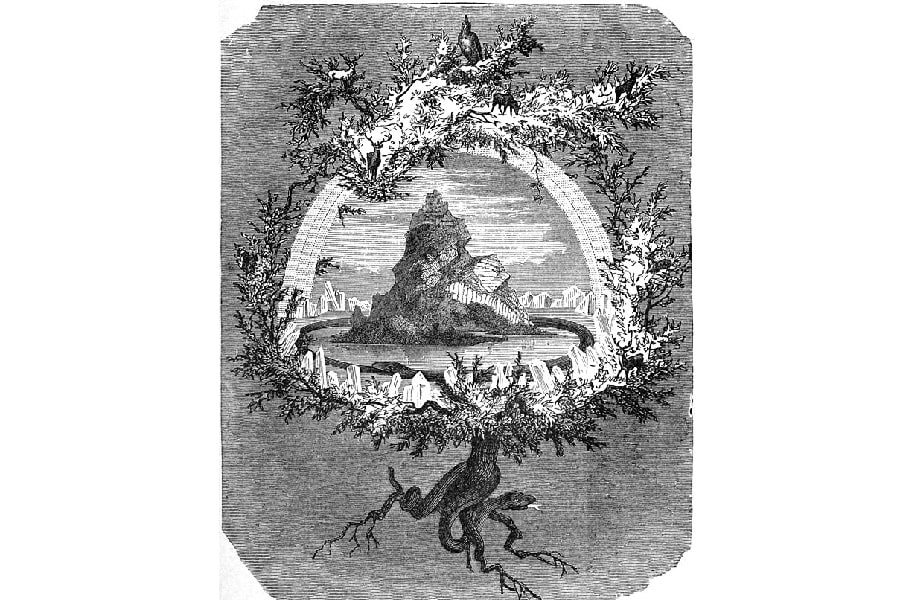
The World Tree, Yggdrasil, was a great ash tree that was a central figure in Norse cosmology. The site where gods would make councils and where the first human laws were created, later played a central role in the story of Odin and even appears at Ragnarok. Yggdrasil is sometimes also known as “the tree of life,” “the center of the nine worlds,” and “the pole of the earth.” Other names were given to Yggdrasil in Norse mythology, including Hoddmimis holt, Mimamidr, and Laeraor.
What Tree Did Odin Hang Himself From?
Odin would hang himself from the Yggdrasil tree for nine days and nine nights. Odin hanging was not an attempt at suicide but an act of sacrifice. During this time he took neither food nor drink, as he sacrificed “himself to himself.” According to some Norse myths, it is by this act that he was able to experience the nine worlds and gain a form of immortality. Havamal, which is part of the poetic edda, records Odin’s words as such:
“I trow I hung on that windy Tree
nine whole days and nights,
stabbed with a spear, offered to Odin,
myself to mine own self given,
high on that Tree of which none hath heard
from what roots it rises to heaven.”
READ MORE: Norse Gods and Goddesses: The Deities of Old Norse Mythology
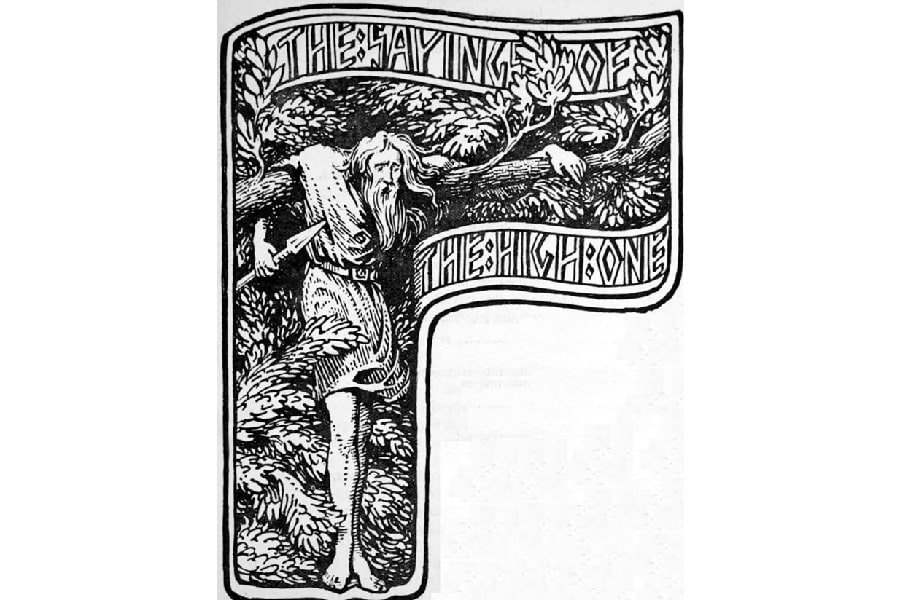
What Does Yggdrasil Mean?
The generally accepted meaning of the name “Yggdrasil” is “Odin’s horse.” This does not mean a literal horse, however, but a term for the gallows (where a man is hanged). “Yggr” is one of Odin’s many names, and “Drassil” means horse in the old Norse language. This would fit with the stories of Yggdrasil and Odin.
However, not all academics agree as to the precise meaning of the name. This tree of life is often referred to as “Askr Yggdrasil” (where “Askr” means “ash tree”), and so some scholars believe that “Yggdrasil” may simply refer to the nine worlds while the tree would be called “ash Yggdrasil.” Regardless, the etymology would be the same.
Unpopular interpretations of the word include “tree of terror,” “yew pillar” and “support pillar.”
Why is Yggdrasil an Ash Tree?
The ash tree is quite important to ancient Norse mythology. According to the Poem Voluspo (or “Wise Woman’s Prophesy”), the first humans were “Ask and Embla,” the Norse words for ash and elm. They were given souls, heat, knowledge/sense, and health. From under the tree came Norns (maidens) “mighty in wisdom” who gave the people law and order. Under the tree also dwelled the dragon, Nithhogg (“the dread biter”), who would gnaw at the tree’s roots, bringing the destructive elements of the universe to the nine worlds.
The European ash, or Fraxinus Excelsior, is quite a mundane tree, found all over Europe. While it desires a lot of water to grow, it grows rapidly and becomes a tall tree in only a decade. Because of its flexibility, shock resistance, and difficulty to split, the wood from this tree’s branches is perfect for the hands of tools and weapons. Even today it is used for snooker cues and tennis rackets. This fast-growing tree’s useful nature offers a possible reason why it was chosen as Odin’s special plant and the center of the universe.
Is Valhalla a Part of Yggdrasil?
While Yggdrasil is often called the “cosmic tree,” Valhalla is not explicitly stated to be a part of it. However, some people suggest that Valhalla is a part of Asgard/Asgaror.
The nine worlds found as part of Yggdrasil include six branches and three roots. The six branches are Asgaror, Vanaheimr, Alfheim, Muspellsheim, Svarlfaheimr, and Niovellir. The first root leads to Hel (or Niflheimr), the second root to Jotunhemir (the land of the giants), and the third root to Midgard (the land of men).
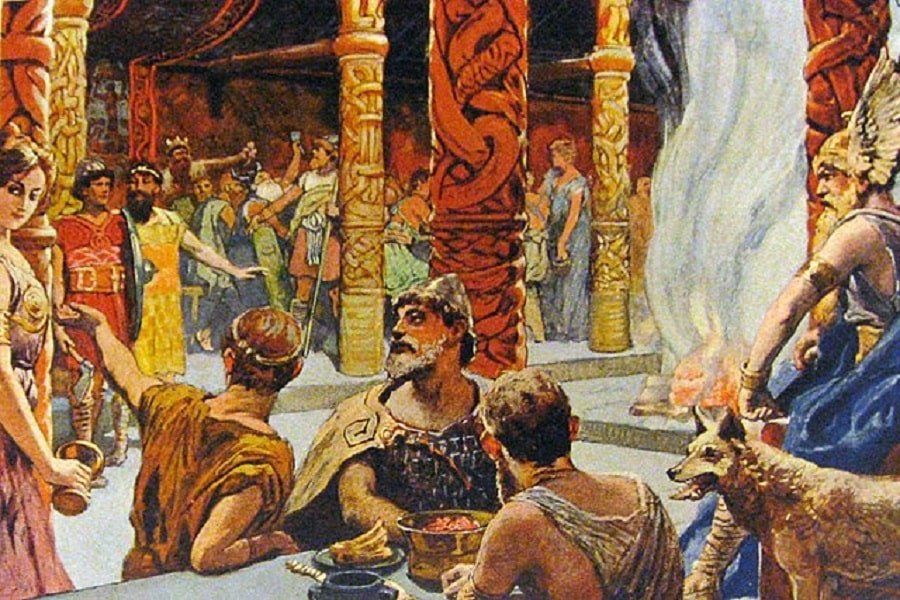
What Else Does the Poetic Edda Say About Yggdrasil?
The Grimnismal is a piece of both prose and poetry, telling the tale of when King Geirroth tortured Grimnir, only to discover it was actually Odin himself. The poetry portion of the text is a monologue by Odin, telling of the worlds and his place in them. Having revealed himself, the repentant Geirroth attempted to save Odin from the torturous fires, only to slip and impale himself on his own sword.
There are a number of references to Yggdrasil in the Grimnismal. In stanzas 29 and 30, Odin describes the journey Thor and the other Aesir gods must take if they are to give judgment against others. “When dooms to give,” the poem reads, “each day they ride to the ash-tree Yggdrasil.”
The poem goes on to describe the tree in great detail:
“Three roots there are,
that three ways run
‘Neath the ash-tree Yggdrasil;
‘Neath the first lives Hel,
‘neath the second the frost-giants,
‘Neath the last are the lands of men.”
Odin then goes on to describe the creatures that live in the tree:
“Ratatosk is the squirrel
who there shall run
On the ash-tree Yggdrasil;
From above the words
of the eagle he bears,
And tells them to Nithhogg beneath.
Four harts there are,
that the highest twigs
Nibble with necks bent back;
Dain and Dvalin,
Duneyr and Dyrathror.
More serpents there are
beneath the ash
Than an unwise ape would think;
[these serpents]
Gnaw at the twigs of the tree.
Odin then gives a final warning about the nature of the tree of the world:
Yggdrasil’s ash
great evil suffers,
Far more than men do know;
The heart bites its top,
its trunk is rotting,
And Nithhogg gnaws beneath.”
This poem is likely the inspiration for the content covered in the Prose Edda, especially in the Gylfanning.
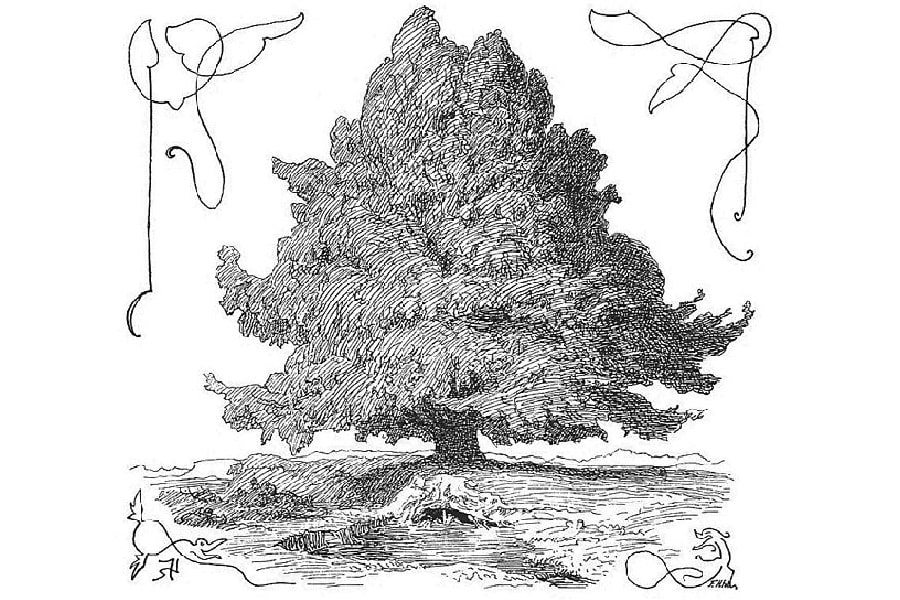
What Does the Prose Edda Say About Yggdrasil?
The most significant mention of Yggdrasil in the Prose Edda can be found in chapter 15 of Gylfanning:
Then said Gangleri: “Where is the chief abode or holy place of the gods?” Hárr answered: ‘That is at the Ash of Yggdrasill; there the gods must give judgment everyday.” Then Gangleri asked: “What is to be said concerning that place?” Then said Jafnhárr: “The Ash is greatest of all trees and best: its limbs spread out over all the world and stand above heaven. Three roots of the tree uphold it and stand exceeding broad: one is among the Æsir; another among the Rime-Giants, in that place where aforetime was the Yawning Void; the third root stands over Niflheim, and under that root is Hvergelmir, and Nídhöggr gnaws the tree’s roots from below. But under that root which turns toward the Rime-Giants is Mímir’s Well, wherein wisdom and understanding are stored; and he is called Mímir, who keeps the well. He is full of ancient lore since he drinks of the well from the Gjallar-Horn. Thither came Allfather and craved one drink of the well; but he got it not until he had laid his eye in pledge.”
The Gangleri in this passage was actually the disguised king, Gylfi, the first king of the Norse people. The Gylfanning was the story of his origins, including his interactions with a more human form of Odin. Harr was one of three men on the thrones who would answer Gylfi’s questions as he learned about the universe. In many interpretations, this man was also Odin himself. This passage contradicts the Poetic Edda, in that the three roots lead to different realms, however, it is otherwise quite similar.
Later in the same story, Gylfi is told more of Yggdrasil. Harr tells him that an eagle sits in the tree, as well as the hawk Vedrfolnir. A squirrel called Ratatoskr also abides, passing messages between the eagle and the dragon, Nidhoggr. Around the trunk are four stags that eat the tree’s leaves. They are called Dainn, Dvalinn, Duneyrr, and Durathror. These deer represent the four winds, with their eating the leaves being representative of how different winds would move about the weather and “tear up the clouds.” This telling only mentions Nidhoggr, and no other serpents lie beneath Yggdrasil.
READ MORE: Snake Gods and Goddesses: 19 Serpent Deities from Around the World
The sacred tree, Yggdrasil lives forever as it is fed from the water of the Well of Urdr, which has healing powers. The dew that falls from its leaves is, according to the myth, the honeydew which feeds bees. Two birds sit under the tree, the original parents of all swans. They too drink from the well.
Chapter 51 of the book describes Ragnarok, and to properly capture how serious this final event is, the writer states that “the Ash of Yggdrasill shall tremble, and nothing then shall be without fear in heaven or in earth.”
In Skaldskaparmal, Yggdrasil is mentioned just once, using the term “Under Earth’s Hazel” as something that looks over an “illustrious one.” This reference shows being shown to be close to the tree of the world is to be seen as god-like or “chosen.”
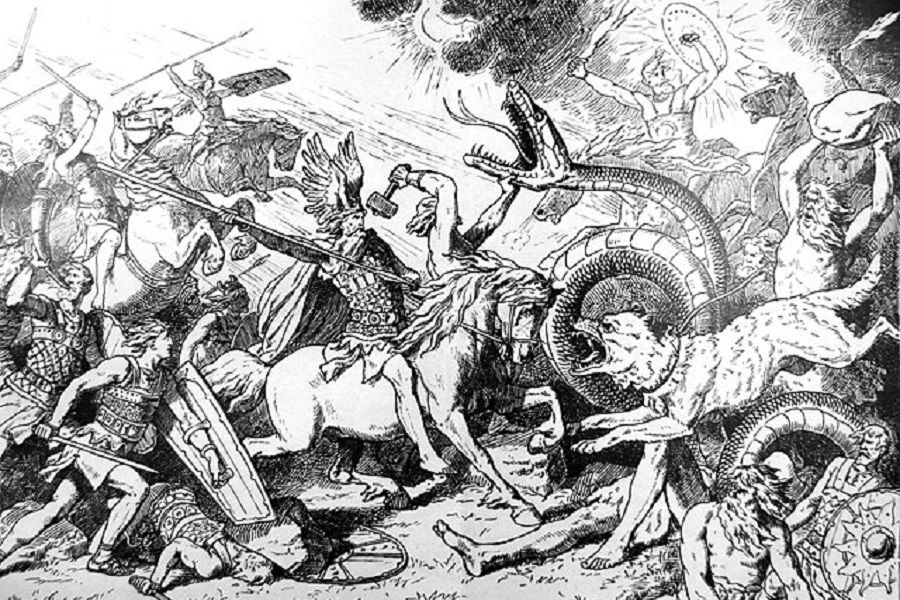
Other Possible Yggdrasil Mentions in Norse Mythology
Mimameior
The sacred tree, Mimameior, may be another example of old Norse storytelling about the world tree. Mimameior, or “Mimir’s Tree,” is talked about in the poetic edda text, Fjolsvinnsmal (or “The Lay of Fjolsvid”). The tree has branches that spread across the earth, unharmed by fire and unable to be cut down by metal. It bears fruit that can help women in labor, ensuring safe childbirth. Academics today believe that Mimameior is simply another name for Yggdrasil. The poem refers to the rooster, Vidofnir, which other texts say lives in Yggdrasil, and “Mimir’s Well” is generally thought to rest under the cosmic tree and provide it with healing water.
READ MORE: Who Invented Water? History of the Water Molecule
Hoddmimis Holt
The poetic and prose edda also refer to Hoddmimis Holt, the location where Líf and Lífþrasir hide. Líf and Lífþrasir are the two human beings destined to survive Ragnarok and continue the race of men. According to the poetic edda Vafthruthnismol (The Ballad of Vafthruthnir), “The morning dews for meat shall they have,” and the Gylfaginning says that “from these folk shall come so numerous an offspring that all the world shall be peopled.”
Many scholars today believe this location to be the ash Yggdrasil, as the story closely reflects similar myths from germanic and Scandinavian culture. A bavarian folktale has a shepherd survive a plague by living inside a tree and surviving off its dew before then repopulating the land. Even old Norse mythology includes tales such as Ovar-Oddr, who heals himself by becoming a “tree man.”
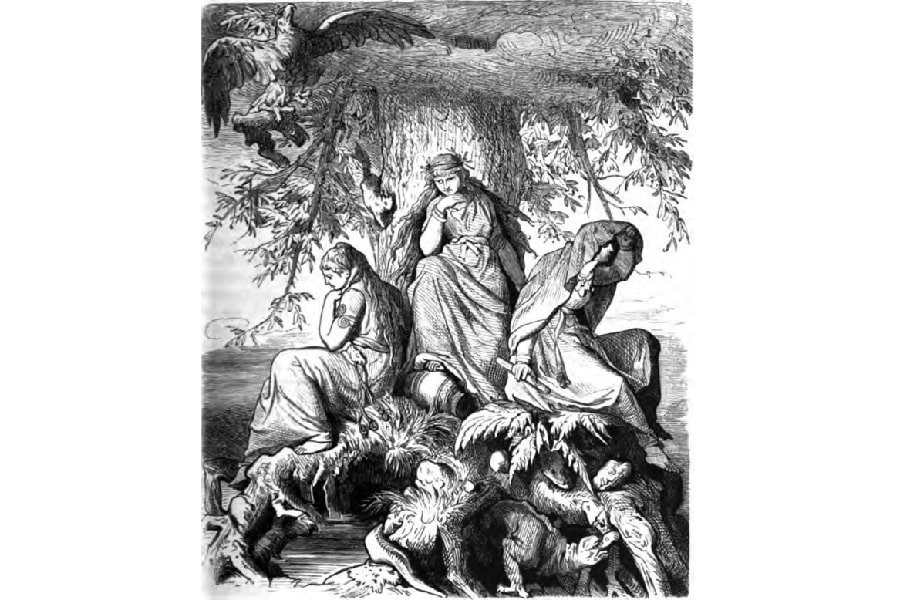
Visual Depictions of Yggdrasil
Unfortunately, archeologists have failed to uncover any visual images from old Norse ruins or Viking artifacts that could be connected to the world tree. This is not surprising as very few stories from Norse mythology were then turned into images that would survive over time. However, there are signs that the giant ash tree was important to nordic worship. For example, many burial mounds and sites of sacred festivals would have a large, singular ash tree planted in the center for protection and luck. At the Swedish template of Uppsala, there was said to have stood a giant tree that would remain green throughout winter. Germanic Saxons would also use an “Irminsul,” a large wooden pillar, as a sacred meeting place and a symbolic representation of the center of the world.
Artwork depicting Yggdrasil would not start appearing until the 19th century, with the rise in new interest in Norse mythology. Danish artist Lorenz Frolich draw a sketch of “Odin Sacrificing Himself Upon Yggdrasil” *1895), while german painter Friedrich Wilhelm Heine would create “the Ash Yggdrasil” (1886) which depicted an entire world resting in the branches of the tree.
Modern carvings of the cosmic tree can now be found at the University of Oslo and the Swedish Museum of National Antiquities, though both were created in the mid-twentieth century.
References to the tree at the center of the world are still rare in modern society. While those interested in philosophy might find it appearing in the works of Thomas Carlyle or John Ruskin, it has never had the same cultural impact as Thor’s Hammer or the Valknut symbol of Odin.